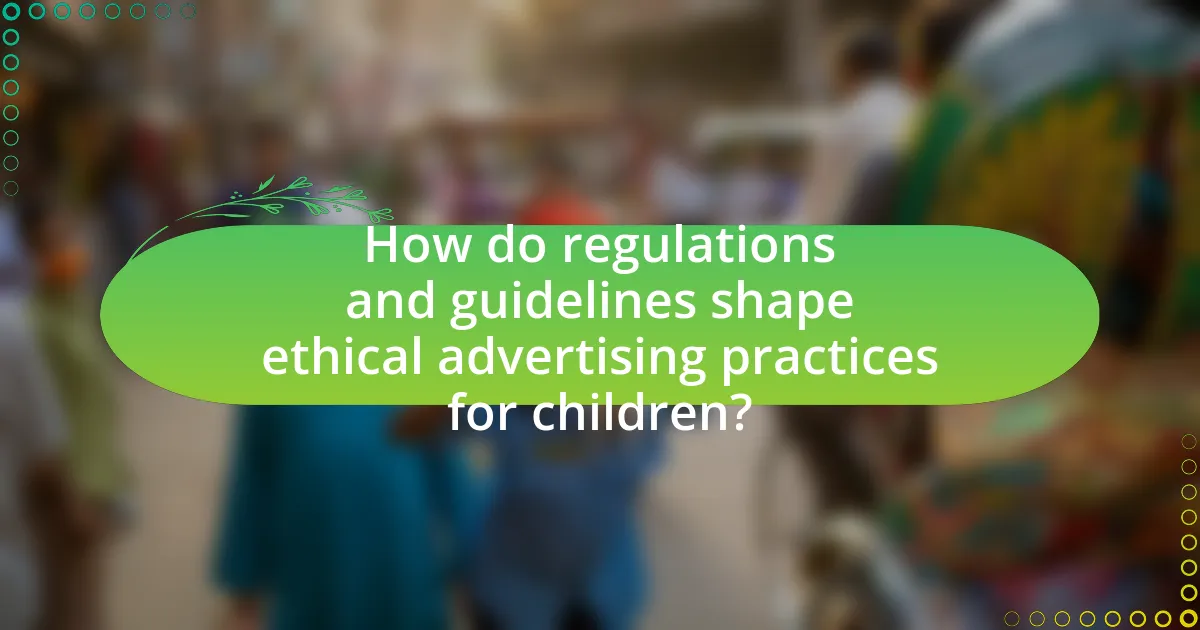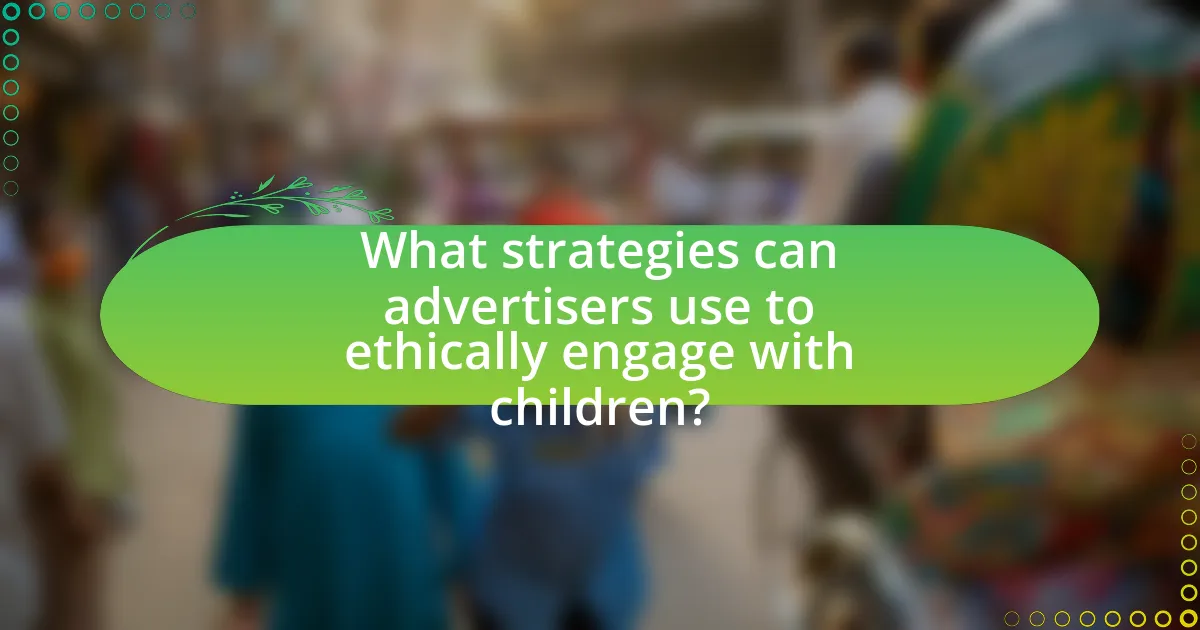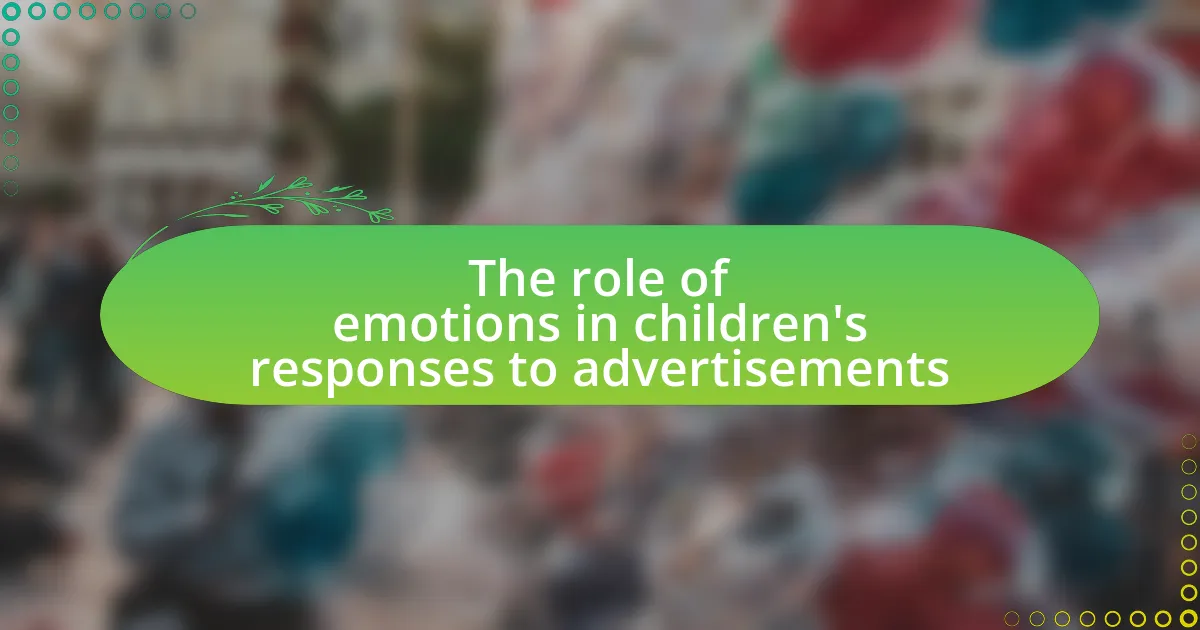The article examines the ethical considerations involved in targeting vulnerable children in advertisements, highlighting issues of exploitation and manipulation due to children’s developmental stages. It discusses the cognitive and emotional vulnerabilities that make children susceptible to persuasive marketing tactics, leading to unhealthy consumption habits and materialistic values. The article also outlines the importance of ethical advertising practices, regulatory frameworks, and the role of parental influence in shaping children’s responses to advertisements. Additionally, it addresses the potential consequences of unethical advertising and offers strategies for advertisers to engage with children responsibly while promoting their well-being.

What are the ethical considerations in targeting vulnerable children in advertisements?
Targeting vulnerable children in advertisements raises significant ethical considerations, primarily centered around exploitation and manipulation. Children, due to their developmental stage, often lack the cognitive ability to critically evaluate advertising messages, making them susceptible to persuasive tactics that can lead to unhealthy consumption habits. Research indicates that children are more likely to accept advertising claims as truthful, which can result in the promotion of products that may not be in their best interest, such as junk food or harmful toys.
Furthermore, ethical frameworks, such as the American Psychological Association’s guidelines, emphasize the need for protecting children from marketing practices that exploit their naivety and emotional vulnerabilities. These guidelines advocate for responsible advertising that prioritizes children’s well-being and promotes positive values. The potential long-term impact of such advertising on children’s health and self-esteem underscores the necessity for ethical scrutiny in this area.
Why is it important to consider ethics when advertising to children?
It is important to consider ethics when advertising to children because children are a vulnerable audience who may not fully understand the persuasive intent behind advertisements. Ethical advertising practices protect children from manipulation and exploitation, ensuring that marketing messages do not take advantage of their naivety. Research indicates that children are particularly susceptible to advertising, with studies showing that they cannot distinguish between entertainment and marketing until around the age of eight. This susceptibility underscores the need for ethical standards that prioritize the well-being of children, preventing harmful effects such as unhealthy eating habits or materialism.
What specific vulnerabilities do children face in advertising contexts?
Children face specific vulnerabilities in advertising contexts, primarily due to their cognitive and emotional development stages. These vulnerabilities include an inability to critically evaluate advertising messages, susceptibility to peer pressure, and a lack of understanding of persuasive intent. Research indicates that children under the age of eight often cannot distinguish between entertainment and advertising, making them more likely to accept misleading claims as truth. Additionally, children are more prone to emotional manipulation through advertisements that exploit their desires for social acceptance and belonging. Studies show that exposure to targeted advertising can lead to unhealthy eating habits and materialistic values, further highlighting the ethical concerns surrounding the marketing practices directed at this demographic.
How do children’s cognitive and emotional development impact their susceptibility to advertising?
Children’s cognitive and emotional development significantly increases their susceptibility to advertising. Young children, typically under the age of eight, often lack the critical thinking skills necessary to understand persuasive intent, making them more likely to accept advertising claims at face value. Research indicates that children are more influenced by emotional appeals in advertisements, as they tend to respond to the feelings and imagery presented rather than the factual content. For instance, a study by the American Psychological Association found that children are particularly drawn to advertisements that feature characters they admire or that evoke strong emotions, leading them to desire the products being advertised. This developmental stage, characterized by concrete thinking and a limited ability to discern commercial intent, makes children particularly vulnerable to manipulative marketing strategies.
What are the potential consequences of unethical advertising to children?
Unethical advertising to children can lead to significant negative consequences, including the promotion of unhealthy behaviors and the development of materialistic attitudes. Research indicates that exposure to misleading advertisements can contribute to poor dietary choices, as children may be influenced to prefer unhealthy foods over nutritious options. A study published in the journal “Pediatrics” found that children exposed to junk food advertisements were more likely to choose those foods, leading to increased rates of childhood obesity. Additionally, unethical advertising can foster unrealistic expectations and desires for products, which can result in emotional distress and dissatisfaction. The American Psychological Association has highlighted that such advertising can exploit children’s developmental vulnerabilities, making them more susceptible to manipulation and less able to critically evaluate marketing messages.
How can misleading advertisements affect children’s health and well-being?
Misleading advertisements can significantly harm children’s health and well-being by promoting unhealthy food choices and fostering unrealistic body images. Research indicates that children exposed to deceptive marketing are more likely to develop poor dietary habits, leading to obesity and related health issues. For instance, a study published in the journal “Pediatrics” found that children who viewed advertisements for high-calorie snacks were more likely to choose those products over healthier options. Additionally, misleading portrayals of body image can contribute to mental health issues, such as low self-esteem and eating disorders, as children may feel pressured to conform to unattainable standards. Thus, the impact of misleading advertisements extends beyond immediate dietary choices, affecting both physical health and psychological well-being.
What role does parental influence play in children’s responses to advertisements?
Parental influence significantly shapes children’s responses to advertisements by guiding their understanding and interpretation of marketing messages. Research indicates that children often rely on their parents for cues on how to react to advertisements, which can either enhance or mitigate the persuasive effects of marketing. For instance, a study published in the Journal of Advertising Research found that children whose parents actively discuss advertisements are more likely to develop critical thinking skills regarding marketing content, leading to more discerning responses. This suggests that parental engagement can serve as a protective factor against the potential manipulative effects of advertisements aimed at children.

How do regulations and guidelines shape ethical advertising practices for children?
Regulations and guidelines shape ethical advertising practices for children by establishing standards that protect young audiences from misleading or harmful content. For instance, the Children’s Online Privacy Protection Act (COPPA) in the United States mandates that companies obtain parental consent before collecting personal information from children under 13, thereby ensuring that advertisements do not exploit children’s naivety. Additionally, the American Psychological Association (APA) emphasizes the need for advertising to be age-appropriate and not to encourage unhealthy behaviors, such as poor dietary choices. These regulations and guidelines create a framework that advertisers must follow, promoting responsible marketing practices that prioritize children’s well-being and safeguard them from exploitation.
What are the key regulations governing advertising to children?
The key regulations governing advertising to children include the Children’s Online Privacy Protection Act (COPPA), the Federal Trade Commission (FTC) guidelines, and various self-regulatory codes such as the Children’s Advertising Review Unit (CARU) guidelines. COPPA mandates that websites and online services directed at children under 13 must obtain parental consent before collecting personal information. The FTC guidelines prohibit deceptive advertising practices and require that advertisements aimed at children be clearly distinguishable from programming. CARU’s guidelines provide additional standards for responsible advertising to children, emphasizing truthfulness and the avoidance of exploiting children’s inexperience. These regulations collectively aim to protect children from misleading and harmful advertising practices.
How do different countries approach advertising ethics for children?
Different countries approach advertising ethics for children through varying regulations and guidelines aimed at protecting minors from exploitative marketing practices. For instance, Sweden and Norway have strict bans on advertising directed at children under 12, emphasizing the need to shield young audiences from commercial pressures. In contrast, the United States employs a self-regulatory system where organizations like the Children’s Advertising Review Unit (CARU) provide guidelines, but enforcement is less stringent compared to Scandinavian countries. The European Union has established directives that encourage member states to adopt measures protecting children from misleading advertisements, reflecting a collective commitment to ethical standards. These approaches highlight the diversity in regulatory frameworks, with some countries prioritizing outright bans while others rely on industry self-regulation.
What organizations are involved in setting advertising standards for children?
Organizations involved in setting advertising standards for children include the American Psychological Association (APA), the Children’s Advertising Review Unit (CARU), and the Federal Trade Commission (FTC). The APA provides guidelines on the psychological impact of advertising on children, while CARU monitors advertising practices to ensure they are truthful and appropriate for children. The FTC enforces laws against deceptive advertising practices, including those targeting children, ensuring compliance with regulations designed to protect young audiences.
How do industry self-regulation practices impact ethical advertising?
Industry self-regulation practices significantly enhance ethical advertising by establishing guidelines that promote responsible marketing, particularly towards vulnerable populations like children. These practices, such as the Children’s Advertising Review Unit (CARU) guidelines, set standards that limit misleading claims and ensure that advertisements are age-appropriate. For instance, CARU’s guidelines require that advertisements directed at children do not exploit their inexperience or credulity, thereby fostering a more ethical advertising environment. Research indicates that adherence to such self-regulatory frameworks leads to a reduction in deceptive advertising practices, ultimately protecting children from harmful marketing tactics.
What are the benefits and limitations of self-regulation in advertising to children?
Self-regulation in advertising to children offers benefits such as promoting ethical standards and fostering responsible marketing practices, which can lead to reduced exposure to harmful content. For instance, industry guidelines often encourage advertisers to avoid misleading claims and to ensure that advertisements are age-appropriate, thereby protecting children’s well-being. However, limitations include the potential for inconsistent enforcement and lack of accountability, as self-regulatory bodies may not have the authority to impose penalties, leading to varying compliance levels among advertisers. Research indicates that self-regulation can be ineffective if not backed by stringent oversight, as evidenced by studies showing that voluntary codes often fail to address all forms of exploitative advertising.
How effective are industry codes of conduct in protecting vulnerable children?
Industry codes of conduct are moderately effective in protecting vulnerable children, primarily by establishing guidelines that promote ethical advertising practices. These codes often include provisions that restrict misleading content, limit the use of fear or pressure tactics, and require transparency in marketing aimed at children. For instance, the Children’s Advertising Review Unit (CARU) enforces guidelines that specifically address the protection of children in advertising, which has led to a reduction in deceptive practices. However, the effectiveness of these codes can be limited by inconsistent enforcement and the voluntary nature of compliance, which may result in varying adherence among companies. Studies indicate that while adherence to these codes can lead to improved advertising practices, gaps remain in their implementation and monitoring, suggesting that additional regulatory measures may be necessary to enhance their effectiveness in safeguarding vulnerable children.

What strategies can advertisers use to ethically engage with children?
Advertisers can ethically engage with children by employing age-appropriate messaging, ensuring transparency, and promoting positive values. Age-appropriate messaging involves creating content that is suitable for children’s developmental stages, which helps them understand the advertisement without manipulation. Transparency requires advertisers to clearly disclose the intent of the advertisement, allowing children to recognize it as marketing rather than entertainment. Promoting positive values, such as teamwork, kindness, and healthy habits, can foster beneficial behaviors in children while aligning with ethical standards. Research indicates that advertisements that prioritize these strategies not only comply with ethical guidelines but also enhance brand trust among parents, as seen in studies conducted by the American Psychological Association, which highlight the importance of responsible advertising practices.
How can advertisers create age-appropriate content that respects children’s vulnerabilities?
Advertisers can create age-appropriate content that respects children’s vulnerabilities by adhering to strict guidelines that prioritize children’s developmental stages and emotional well-being. This involves using language, imagery, and themes that are suitable for the target age group, ensuring that the content does not exploit children’s naivety or lack of experience. For instance, the American Psychological Association emphasizes the importance of avoiding manipulative tactics that could lead to unhealthy behaviors or unrealistic expectations among children. Additionally, incorporating educational elements can enhance the value of the content, fostering positive learning experiences while still engaging young audiences.
What techniques can be used to ensure transparency in advertising to children?
Techniques to ensure transparency in advertising to children include clear labeling of advertisements, using age-appropriate language, and implementing educational content that distinguishes between entertainment and marketing. Clear labeling helps children recognize when they are being marketed to, which is supported by guidelines from organizations like the American Psychological Association, emphasizing the need for distinct separation between content and advertisements. Age-appropriate language ensures that children understand the message without manipulation, while educational content can inform them about advertising practices, fostering critical thinking skills. These techniques collectively promote ethical advertising practices that respect children’s vulnerability.
How can advertisers involve parents in the advertising process to enhance ethical practices?
Advertisers can involve parents in the advertising process by creating advisory boards that include parents to provide insights on ethical standards and messaging. This approach allows parents to voice their concerns and preferences, ensuring that advertisements align with family values and ethical considerations. Research indicates that parental involvement can lead to more responsible advertising practices, as seen in studies where parental feedback resulted in more transparent marketing strategies that prioritize children’s well-being. By actively engaging parents, advertisers can enhance trust and accountability in their campaigns, ultimately fostering a more ethical advertising environment.
What best practices should advertisers follow when targeting children?
Advertisers should prioritize transparency and age-appropriate content when targeting children. This involves clearly disclosing the intent of advertisements and ensuring that the messaging is suitable for the developmental stage of the child audience. Research indicates that children under the age of 8 often cannot distinguish between advertising and entertainment, making it crucial for advertisers to avoid manipulative tactics. Additionally, adhering to guidelines set by organizations such as the American Psychological Association, which emphasizes the importance of protecting children from exploitative marketing practices, reinforces ethical advertising. By following these best practices, advertisers can foster a responsible approach that respects the vulnerabilities of child consumers.
How can advertisers balance commercial interests with ethical responsibilities?
Advertisers can balance commercial interests with ethical responsibilities by implementing transparent marketing practices that prioritize the well-being of vulnerable audiences, particularly children. This involves adhering to established guidelines, such as those set by the American Psychological Association, which recommend avoiding manipulative tactics that exploit children’s developmental vulnerabilities. Additionally, advertisers can engage in responsible messaging that promotes healthy behaviors and choices, thereby aligning their commercial goals with societal values. Research indicates that ethical advertising not only fosters trust and brand loyalty among consumers but also enhances long-term profitability, demonstrating that ethical considerations can coexist with commercial success.
What role does feedback from children and parents play in shaping ethical advertising strategies?
Feedback from children and parents is crucial in shaping ethical advertising strategies by providing insights into the perceptions and impacts of advertisements on young audiences. This feedback helps advertisers understand the values and concerns of families, ensuring that marketing practices align with ethical standards that protect vulnerable children. For instance, research by the American Psychological Association indicates that parental input can lead to more responsible advertising that avoids exploiting children’s naivety and promotes positive messages. By incorporating this feedback, companies can create advertising strategies that not only comply with ethical guidelines but also foster trust and credibility with consumers.
What are the future trends in ethical advertising to children?
Future trends in ethical advertising to children include increased regulation, transparency, and the use of technology to promote responsible messaging. Regulatory bodies are likely to impose stricter guidelines on advertising practices aimed at children, as seen in recent initiatives by the Federal Trade Commission to protect young audiences from misleading content. Transparency will become essential, with brands expected to disclose their advertising strategies and the potential impact on children’s health and well-being. Additionally, advancements in technology, such as artificial intelligence, will enable advertisers to create age-appropriate content that aligns with ethical standards, ensuring that messages are not only engaging but also educational and beneficial for children’s development.
How might technology influence ethical considerations in advertising to children?
Technology significantly influences ethical considerations in advertising to children by enabling targeted marketing strategies that can exploit children’s vulnerabilities. Advanced data analytics and algorithms allow advertisers to gather detailed information about children’s online behaviors, preferences, and demographics, leading to personalized advertisements that may manipulate their purchasing decisions. For instance, a study by the American Psychological Association highlights that children are particularly susceptible to persuasive techniques used in digital media, which raises concerns about their ability to critically evaluate advertisements. This targeted approach can blur the lines between entertainment and advertising, making it difficult for children to discern commercial intent, thus necessitating stricter ethical guidelines to protect this vulnerable demographic.
What emerging ethical challenges should advertisers be aware of in the coming years?
Advertisers should be aware of the emerging ethical challenges related to the targeting of vulnerable children in advertisements, particularly concerning data privacy, manipulation, and the impact of digital marketing. As technology advances, advertisers increasingly collect data on children’s online behavior, raising concerns about consent and privacy violations. Research indicates that children may not fully understand the implications of data sharing, making them susceptible to exploitation. Additionally, the use of persuasive techniques, such as gamification and influencer marketing, can manipulate children’s emotions and decision-making processes, leading to unhealthy consumption patterns. The American Psychological Association has highlighted that such practices can contribute to issues like obesity and materialism among children. Therefore, advertisers must navigate these ethical challenges carefully to protect vulnerable populations while maintaining compliance with evolving regulations.
What practical tips can advertisers implement to ensure ethical practices when targeting children?
Advertisers can ensure ethical practices when targeting children by adhering to guidelines that prioritize transparency, age-appropriate content, and parental involvement. Implementing clear labeling of advertisements as such helps children distinguish between content and marketing. Additionally, creating age-appropriate messaging that avoids exploiting children’s naivety is crucial; for instance, using relatable characters and scenarios that resonate with their experiences without misleading them. Engaging parents in the advertising process, such as providing them with information about the products and encouraging family discussions, fosters a responsible approach. Research indicates that advertisements aimed at children should not promote unhealthy food choices, as studies show that exposure to such marketing can lead to poor dietary habits (Harris et al., 2009, “Effects of Food Marketing on Children’s Preferences”). By following these practices, advertisers can contribute to a safer and more ethical advertising environment for children.






